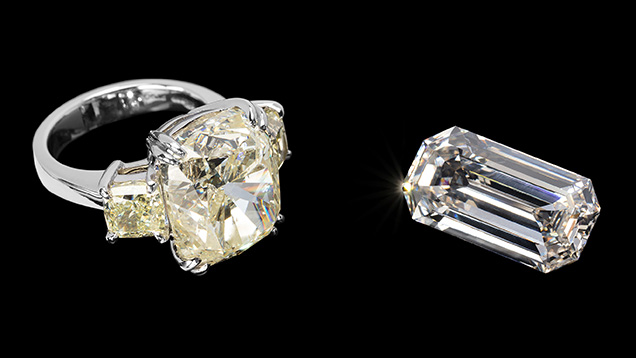Smithsonian’s Great American Diamonds Exhibit

Two extraordinary American diamonds (see above) have found a home at the Smithsonian’s National Museum of Natural History, where they were unveiled as part of the new Great American Diamonds exhibit in June. The 16.87 ct Freedom diamond, the largest faceted diamond of U.S. origin, was fashioned from a 28 ct crystal unearthed at Colorado’s Kelsey Lake mine in 1997. The cushion-cut diamond is now set in a ring donated by Robert E. and Kathy G. Mau. The second diamond on exhibit, the emerald-cut Uncle Sam, was faceted from the largest uncut American diamond crystal ever discovered at 40.23 ct. Uncovered at Arkansas’ Crater of Diamonds in 1924, the flawless 12.42 ct pinkish brown stone was recently recovered from a private collection (after being missing for decades) and donated by Peter Buck. This is the first time the Uncle Sam has been exhibited in more than 50 years.
While diamonds from the United States are exceptionally rare, the two mines in Colorado and Arkansas produced tens of thousands of carats of rough diamonds, from 1919 to 1926 at the Crater of Diamonds and 1996 to 2001 at Kelsey Lake. “Most people are surprised to learn that diamonds have been mined in the United States, and as the national museum, we are delighted to introduce these great American diamonds to our visitors,” said Dr. Jeffrey Post, the museum’s curator-in-charge of gems and minerals.
Joining these two impressive donations in the Great American Diamonds exhibit are two uncut diamonds from the museum’s existing collection. The Canary, a golden yellow crystal weighing 17.85 ct, is one of the largest uncut diamonds from Arkansas. The 6.45 ct Colorado, which displays the typical octahedral shape of a natural diamond crystal, was recovered from the kimberlite host rock during mining operations at Kelsey Lake. As part of the Smithsonian’s National Gem and Mineral Collection, these four stones are among more than 10,000 precious stones and pieces of jewelry, including the iconic Hope diamond.



